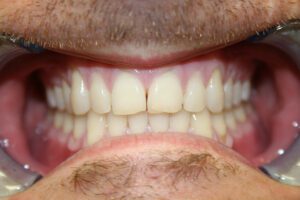
The way our upper and lower jaw fit together is known as occlusion. Traumatic occlusion is also called a bad bite in dentistry, and it is considered a disease requiring prompt treatment. In this condition, a person’s teeth are not aligned properly. This affects their smile and the normal functioning of the mouth.
What is Traumatic Occlusion?
A crowded mouth in which there is not enough room for all the teeth to arrange in a line also sometimes leads to traumatic occlusion or malocclusion. Another important thing to consider is the right alignment of the upper and lower jaw; if it does not close properly during chewing there is a strong chance of developing many other oral complications later on in life.
How is Traumatic Occlusion Treated By a Dentist?
Occlusal Equilibration
Traumatic occlusion is mostly treated by a procedure called occlusal equilibration in which the chewing and biting surfaces of teeth are grinded to achieve balance and proper alignment. By doing so the pressure on individual teeth is lessened, thereby making them less susceptible to becoming weak or contaminated.
Occlusal Restoration
Other than occlusal equilibration, occlusal restoration is also sometimes prescribed to correct the alignment of teeth. Crooked teeth are replaced or reconstructed through restorative procedures in order to improve the normal functioning of the mouth.
Jaw Repositioners
Appliances known as jaw repositioners are also used for the treatment of traumatic occlusion. These devices are worn like braces and need to be adjusted and tightened after regular intervals of time until the desired tooth position is achieved. These appliances provide a temporary solution and may require other complex treatments to permanently correct the problem.
What Happens if Traumatic Occlusion is Left Untreated?
If the traumatic occlusion is not treated on time the chances of periodontal disease increase greatly due to teeth that are not straight or properly aligned. The biting pressure exerted by other teeth makes them become loose and eventually become diseased. Proper identification of this condition is necessary in order to treat it rightly. People who are in a habit of biting their nails or sucking their thumb are often victims of traumatic occlusion. If proper treatment is not provided, it leads to the next stage of this condition known as occlusal trauma, which can be primary or secondary.
Additional Treatments May Be Needed
These treatments include orthodontics, occlusal adjustment, and orthognathics. In some cases, all of these treatments are required to correct the alignment of different teeth and resolve traumatic occlusion.
If you suffer from constant headaches due to misalignment of your jaw, you may need to opt for one of these treatments to prevent further damage.
What is the Difference Between Orthognathics and Orthodontics?
Orthognathics is a term used to describe the correctness of upper and lower jaw alignment and the treatment is called orthognathic surgery. This type of surgery is intended to correct the bone relationship rather than straightening of the teeth.
If there is a need to straighten the teeth, orthodontics (braces) are used.
- Occlusal or bite adjustment is similar to occlusal equilibration. How much adjustment is required is determined by using computer-based occlusal analysis. This type of adjustment is needed when there are loose or shifting teeth, severe grinding or clenching during sleep, and sensitivity to temperature.
- Traumatic occlusion can also be treated by Invisalign®, Crowns, or even braces.
If you believe you may be suffering from traumatic occlusion, please call to schedule an appointment with Dr. Q in our Monrovia dental office.

